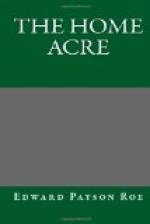We will suppose that the spring plantings of trees have been made with open spaces reserved for the favorite games. Now the ground can be prepared for grass-seed, for it need not be trampled over any more. If certain parts have become packed and hard, they should be dug or plowed deeply again, then harrowed and raked perfectly smooth, and all stones, big or little, taken from the surface. The seed may now be sown, and it should be of thick, fine-growing varieties, such as are employed in Central Park and other pleasure-grounds. Mr. Samuel Parsons, Jr., Superintendent of Central Park, writes me: “The best grass-seeds for ordinary lawns are a mixture of red-top and Kentucky blue-grass in equal parts, with perhaps a small amount of white clover. On very sandy ground I prefer the Kentucky blue-grass, as it is very hardy and vigorous under adverse circumstances.” Having sown and raked in the seed very lightly a great advantage will be gained in passing a lawn-roller over the ground. I have succeeded well in getting a good “catch” of grass by sowing the seed with oats, which were cut and cured as hay as soon as the grain was what is termed “in the milk.” The strong and quickly growing oats make the ground green in a few days, and shelter the slower maturing grass-roots. Mr. Parsons says, “I prefer to sow the grass-seed alone.” As soon as the grass begins to grow with some vigor, cut it often, for this tends to thicken it and produce the velvety effect that is so beautiful. From the very first the lawn will need weeding. The ground contains seeds of strong growing plants, such as dock, plantain, etc., which should be taken out as fast as they appear. To some the dandelion is a weed; but not to me, unless it takes more than its share of space, for I always miss these little earth stars when they are absent. They intensify the sunshine shimmering on the lawn, making one smile involuntarily when seeing them. Moreover, they awaken pleasant memories, for a childhood in which dandelions had no part is a defective experience.
In late autumn the fallen leaves should be raked carefully away, as they tend to smother the grass if permitted to lie until spring. Now comes the chief opportunity of the year, in the form of a liberal top-dressing of manure from the stable. If this is spread evenly and not too thickly in November, and the coarser remains of it are raked off early in April, the results will be astonishing. A deep emerald hue will be imparted to the grass, and the frequent cuttings required will soon produce a turf that yields to the foot like a Persian rug. Any one who has walked over the plain at West Point can understand the value of these regular autumnal top-dressings. If the stable-manure can be composted and left till thoroughly decayed, fine and friable, all the better. If stable-manure can not be obtained, Mr. Parsons recommends Mapes’s fertilizer for lawns.




